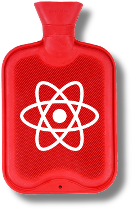README
react-heatpack
A heatpack command for quick React development with webpack hot reloading.
Note: if you're primarily looking for a live reloading environment to tweak and iterate on encapsulated React components in, go look at Cosmos first!
Usage
Install the heatpack command globally:
npm install -g react-heatpack
Call heatpack with the path to a module which either:
- runs
ReactDOM.render(...), - exports a single React component,
- or exports a React element (e.g.
module.exports = <div></div>)
$ heatpack src/index.js
react-heatpack listening at localhost:3000
webpack built d6953adb7d78e400f9d3 in 3731ms
Open http://localhost:3000/ and your app should be served and will be hot reloaded when you make any changes.
Any syntax errors or errors in render() methods will be overlaid on the screen.
Configured loaders
Webpack loaders are configured for the following:
JavaScript
JavaScript modules can have .js or .jsx extensions and will be transformed with Babel (version 5), so you can use:
- JSX
- ECMAScript 6 features
- ECMAScript 7 proposals experimentally supported by Babel 5.
You can also require .json files as normal.
CSS
Require CSS files from your JavaScript as if they were any other module, e.g.:
require('./Widget.css')
Styles will be automatically applied to the page and hot reloaded when you make a change.
Vendor prefixes will be automatically applied to your CSS, as necessary.
Images and font files referenced from your CSS will also be handled for you.
See the css-loader documentation for more information on what webpack allows you to do when you start using require() for CSS.
Images
Require image files from your JavaScript as if they were any other module, e.g.:
<img src={require('./logo.png')}/>
Small images will be inlined as data: URIs and larger images will be served up by webpack.
Gotcha avoidance
Root element
Since you should never render to document.body, the page served up by heatpack includes a <div id="app"></div> element for your app to render into.
Tips & tricks
Single-file hot reloading with multiple components
If you define and render a bunch of React components in the same module, they can still be hot reloaded.
This can be handy for quickly hacking together something which needs multiple components without having to create separate modules for them:
var React = require('react')
var ReactDOM = require('react-dom')
var App = React.createClass({
render() {
return <div><Menu/><Content/></div>
}
})
var Menu = React.createClass({
render() {
return <nav><ul><li>Item</li></ul></nav>
}
})
var Content = React.createClass({
render() {
return <section><h1>Content</h1></section>
}
})
ReactDOM.render(<App/>, document.querySelector('#app'))
Beyond heatpack
Check out rwb: the React workbench, which serves and creates production builds for React apps without having to set up your own build tools.
Alternatively if you want set up your own webpack config for a production build, these resources should be useful:
petehunt/webpack-howto is a great place to start for the most common "How do I configure X?" questions about webpack.
cesarandreu/web-app describes itself as a "reasonable starting point for building a web app" - as such, it probably doesn't have everything you'll end up needing, but it's a working out-of-the-box example of building for dev, test and production, with meticulously-commented webpack config which links out to relevant documentation and other resources.
SurviveJS - Webpack and React - while this entire book is a useful reference for working with React and webpack, the Deploying Applications chapter is of particular interest for putting together a production build.

